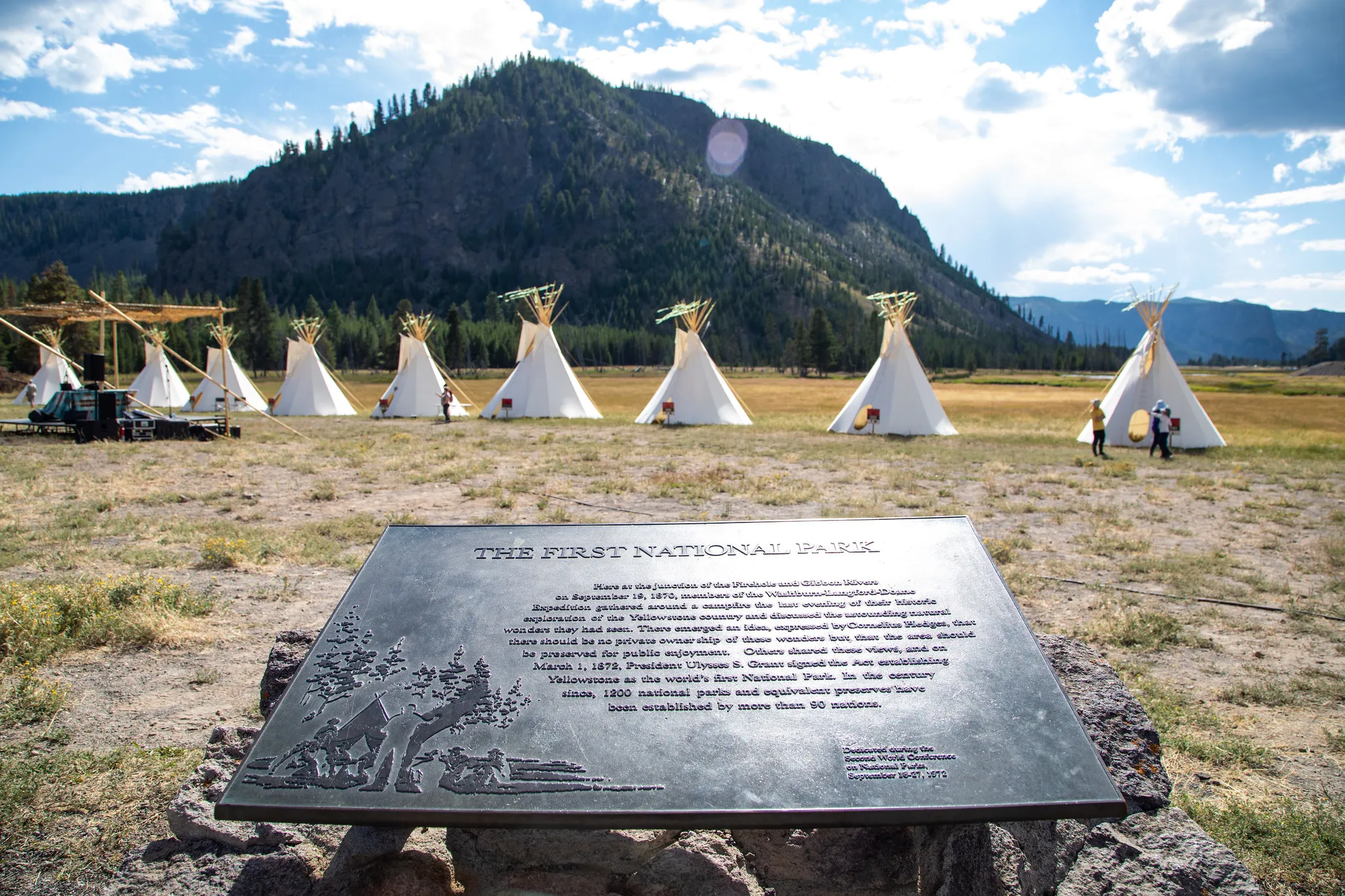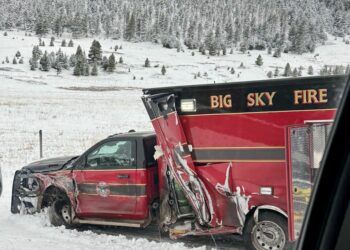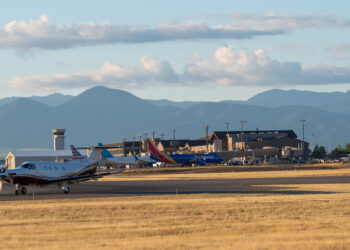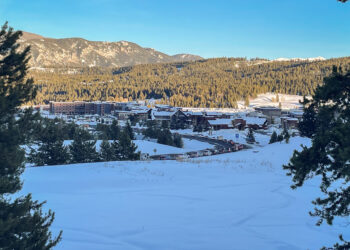Native American tribes and legal scholars are asserting their right to hunt, fish, gather, shape the future of and perhaps someday even reacquire the land that’s now the park.
By Mike Koshmrl WYOFILE
OLD FAITHFUL, Wyo. – Tom Wadsworth read straight from the 154-year-old treaty that displaced his ancestors from their land as he made a case that Shoshone and Bannock tribal members should be allowed to hunt, fish and gather inside Yellowstone National Park.
Signed at Fort Bridger on July 3, 1868 in what’s now southern Wyoming, the treaty granted the Shoshone and Bannock native people the right to “hunt on the unoccupied lands of the United States” in perpetuity, so long as game was found and peace with white people maintained.
Yet, today, with a few exceptions, hunting isn’t allowed by tribal members or anyone else in Yellowstone or the rest of the National Park Service’s 400-plus units in the Lower 48. Wadsworth, the captain game warden for the Shoshone-Bannock tribes, suggested the federal government didn’t uphold its end of the deal.
“This is what gives us the right to keep hunting,” Wadsworth, with treaty text in hand, told a crowd of his tribal members inside a Yellowstone gymnasium. “And … I want y’all to realize that hunting doesn’t just mean going out and hunting animals. It also means fishing, it also means gathering — we did not have a word in our language to differentiate between those things.”

Wadsworth is not alone in calling for change. Tribal leaders, Park Service administrators, legal scholars and others are reconsidering the past and reimagining a Park Service future in which Native American tribes play a much larger role. Amid Yellowstone’s 150th anniversary, there’s a growing sense that it’s time to reverse historical wrongs, honor treaty promises, recognize Yellowstone and other parks as traditional Indigenous lands and incorporate tribes into National Park Service decision-making.
Re-Indigenizing Yellowstone, a 94-page article recently published in the Wyoming Law Review, outlines several paths that could reverse course on a century and a half of ignoring, erasing and marginalizing the history of Indigenous exclusion, absence and disconnection from Yellowstone.
“Yellowstone can once again change the world,” authors Kekek Jason Stark, Autumn Bernhardt, Monte Mills and Jason Robison wrote. “Ultimately, re-indigenizing Yellowstone can restore the shine to the nation’s original crown jewel and help ensure that all Americans can look forward to the park’s next 150 years and beyond.”
Pivot point
The National Park Service has embraced Yellowstone’s 150th anniversary as a historical pivot point and an opportunity to mend tribal relations and bolster Native American involvement. Much of the effort has been ceremonial: There have been roundtable discussions, teepee villages erected, a rematriation performance and artwork showcase and other activities and gatherings celebrating Yellowstone’s tribal heritage. At the Shoshone-Bannock gathering where Wadsworth spoke, Yellowstone Superintendent Cam Sholly presented the tribe’s chairman, Nathan Small, with a medallion adorned with 23 bison to symbolize all that remained of the species before bison were brought back from the brink at the Lamar Buffalo Ranch more than a century ago.

“Now there’s over 6,000 [bison]. I call that a start,” Sholly told Small. “It’s extremely inspiring to have you here. The 150th anniversary of Yellowstone, it’s something that’s important to not only Americans, but people around the world — it’s America’s first national park — but we realize that it has a different meaning for many of you.”

Twenty minutes earlier, Shoshone-Bannock Land Use Policy Commissioner Darrell Shay said as much. “It’s not really a celebration,” Shay said. “Because this is ours, we never gave it up. We were the last group of Indians that were here, and we got shipped out — forced out by the cavalry.”
Pawnee Nation tribal member and attorney Brett Chapman called the park’s recent tribal outreach a “complete PR stunt,” in an interview with E&E News.
Amid such criticism, Sholly has maintained that he is making an earnest effort to bring about a new era of tribal-park relations.

“Maybe people don’t believe it, maybe we need more time [and] trust to build, but that is a two-way street,” Sholly told a panel during a discussion about sovereign relations in Yellowstone at a sesquicentennial symposium in Cody.
‘Give us access’
“I think what we’re asking for is to allow us to tell our story, but also allow us to have access,” Eastern Shoshone Business Council Member and historian John Washakie said during a panel discussion on Native people’s historical and cultural connections to the park. “Give us access. We won’t disturb things, we won’t bother things. We’ll just take what we need.”
In 2016, the National Park Service modified its regulations to allow federally recognized tribes to gather and remove plants or plant parts for traditional, non-commercial purposes, but the result isn’t a blanket entitlement. Tribes must strike agreements with the federal agency specifying what plants may be gathered, what quantities and which tribal members are permitted. That hasn’t happened in Yellowstone, but Sholly told WyoFile that those discussions are underway.
“The difficulty with Yellowstone is you have 27 different affiliated tribes, and it’s important to understand what the cumulative gathering request is by all those tribes,” he said. “What do the tribes want to collect? How much? Where? We’ll assess that and make determinations from there.”

Hunting in the park is a different beast.
The Lacey Act — established decades after the 1868 Fort Bridger Treaty promised the Shoshone and Bannock they could “hunt on the unoccupied lands” — prohibited unauthorized hunting, killing and capturing any bird or wild animal in Yellowstone and, later, other federal lands. According to the Wyoming Law Review article, near the turn of the 20th century a Bannock leader from the Fort Hall Indian Reservation named Race Horse agreed to kill seven elk in Uinta County and be taken into custody to test the tribe’s treaty rights. The U.S. Supreme Court ruled that state game laws still applied, even when they conflicted with treaty rights. That ruling held precedent for over 120 years until 2019 when the court ruled in Herrera v. Wyoming that a Crow Tribe member’s off-reservation treaty hunting rights remained intact.
“The Supreme Court reaffirmed those continuing rights in the national forest,” Mills, a Re-Indigenizing Yellowstone co-author who directs the University of Washington’s Native American Law Center, told WyoFile. “Conceivably, although it hasn’t been tested yet, ShoBan have those rights too, because their treaty language is essentially the same [as the Crow’s].”
National Park Service administrators have historically argued that Yellowstone was “occupied” — and thus exempt from the right to hunt “unoccupied lands” — when it became a national park in 1872.
Scholars see two ways to “test” tribal rights and settle the question about access to hunting in places like Yellowstone. One, a Shoshone-Bannock member could follow Race Horse’s example and force the courts to decide directly in the post-Herrera world by hunting in the park. Another way forward, Mills said, is through collaboration and co-management. That’s been the formula for tribal bison hunting outside of national park boundaries.
Wadsworth, the Shoshone-Bannock captain game warden, told WyoFile he favors the collaborative approach.
“That step would be a government-to-government meeting, between the tribes and the Park Service, to move forward and see what can be done,” Wadsworth said.
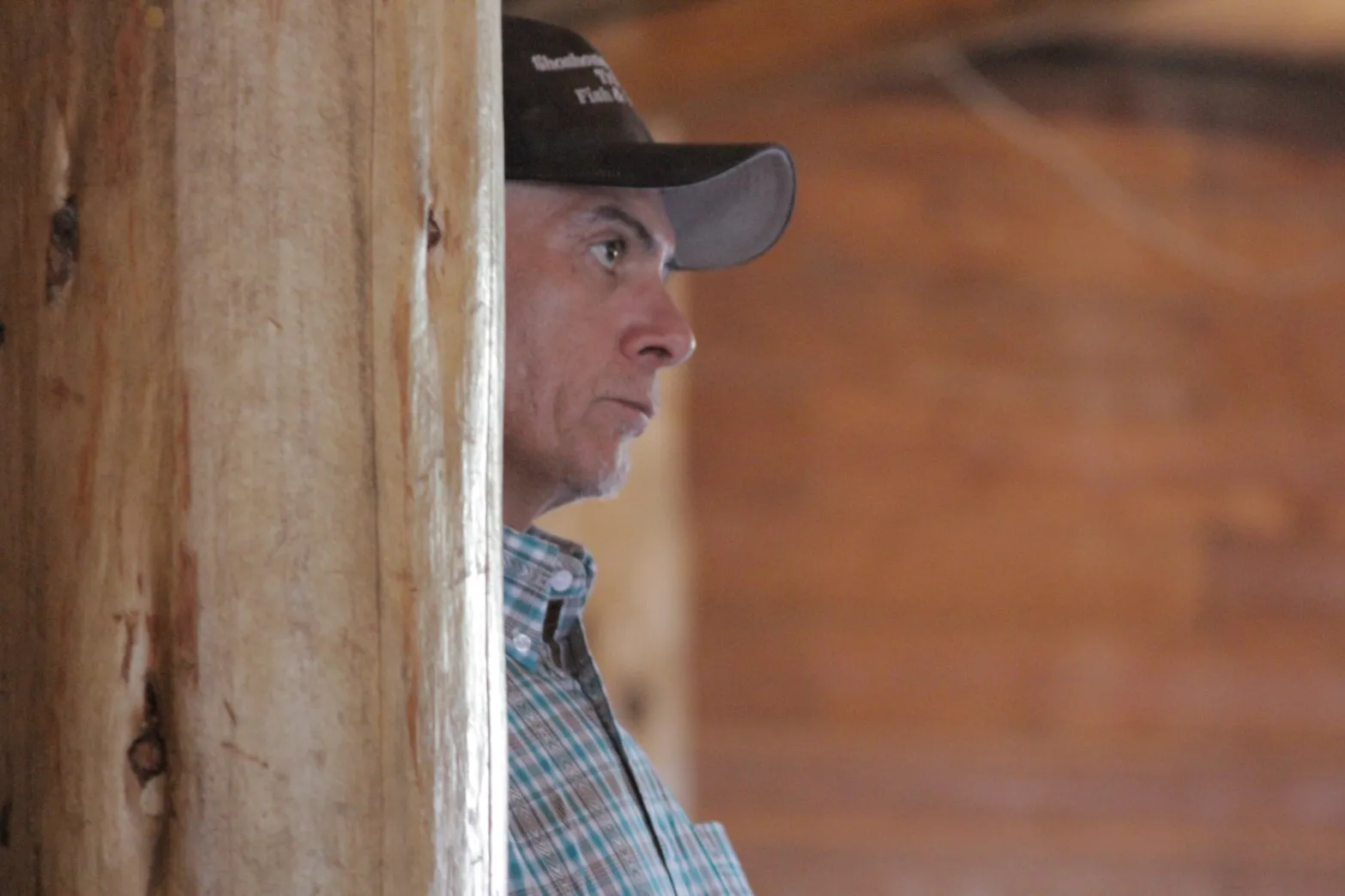
Those are complex conversations because of the number of Yellowstone-affiliated tribes involved: The Park Service recognizes 27, though Mills and others argue there are more. They are also sure to be contentious.
“Even bison hunting outside of the park, it’s been at least 25 years of litigation,” Mills said. “The development of the [Interagency Bison Management Program], it’s just been a long process and that doesn’t even get into the treaty rights issues.”
Nevertheless, the movement to increase Indigenous access and influence over management of Yellowstone and all national parks continues to gain steam.
Wes Martel, a former longtime Eastern Shoshone Business Council member, said that Native American National Park Service Director Chuck Sam’s two-day visit to the Wind River Indian Reservation to discuss tribal involvement and inclusion in the parks this summer was significant. Still, he does not expect change to come easy.
“We have made progress, but today’s political climate is just so toxic,” said Martel, who now works for the Greater Yellowstone Coalition. “Montana, Wyoming and Idaho — all three of those states — are very opposed to tribal issues. They’re anti-Indian, they’re anti-buffalo, they’re anti-wolf, anti-grizzly, they’re anti-conservation.”
‘Re-Indigenizing’
Yellowstone has made headway on improving its relations with tribes. At the dawn of the 20th century, there were attempts to use Native people essentially as props to bolster tourism. One infamous example is that of an “aboriginal exhibit” at Yellowstone Lake’s Dot Island. Businessman E.C. Waters tried but “had no luck convincing any Crow to camp in the middle of Yellowstone Lake” alongside bison for the viewing pleasure of summer tourists, according to the Wyoming Law Review article.
In the last 30 years, federal-tribal relations in Yellowstone have changed “drastically.” “The Park Service and Yellowstone-associated tribes have sought connection,” the legal scholars write.
There’s still a long way to go, the authors say. They don’t make specific recommendations for how the NPS and tribes should move forward in their paper, but provide “a range of options.”
“Regardless of whatever’s the most efficient and what avenues are available,” Mills said, “really it’s as much about the process of engagement and collaboration and the relationship that’s being built between the Park Service and the tribes.”

One of those paths forward they lay out is “radical realignment,” like the approach espoused by the #Landback movement. That could mean the “undoing of the large-scale displacement of tribes” and returning of the title to Yellowstone National Park.
In their review, the law professors also offer up federal-tribal government partnership models. Former Secretary of the Interior Sally Jewell empowered the Park Service to develop such partnerships with a 2016 secretarial order. The Re-Indigenizing Yellowstone document lists a slate of partnership templates, like co-management of the Bears Ears National Monument, which is governed in part by an inter-tribal commission.
The paper also contemplates ways to improve consultation and engagement with Indigenous people. Sholly, speaking at the Cody symposium, described the consultation status quo — which entails the NPS sending tribes formal letters about projects — as “artificial” and “bureaucratic.” Yellowstone will keep doing it to meet its statutory obligations and it’s “important,” he said, but “the real progress” is going to be made through relationship building with tribal councils and members.
Last, the Native law scholars suggest in their Wyoming Law Review paper the Park Service could build tribal capacity through business. For example, at Grand Portage National Monument — which Sholly used to oversee as the Park Service’s Midwest Region director — the maintenance program is contracted out to the Grand Portage Band of Lake Superior Chippewa, or Ojibwe.
Ultimately, the Re-Indigenizing Yellowstone authors argue that Yellowstone and the tribes must hash out a tailor-made arrangement.
“[E]nvisioning a new management paradigm for the world’s first national park,” they write, “must go beyond the potential of existing collaborative frameworks to ensure it functions effectively in practice.”
In Martel’s view, Yellowstone bringing the tribes to the literal table will be key to making the nation-to-nation relationship work. The tangible actions might come along piecemeal, he said.

“Let’s designate areas where there could be ceremonies,” Martel said. “Let’s establish traditional use areas … We’re also talking about creating an Indigenous advisory board for Yellowstone.”
Sholly, addressing the Shoshone-Bannock people at Old Faithful, said the ceremonies and spotlight on Indigenous issues during Yellowstone’s sesquicentennial are just the start.
“We’ve made progress, but we have got a long way to go,” Yellowstone’s superintendent told the tribes. “We look forward to the rest of this ceremony and, most importantly, further dialogue, together in the future, about what is possible.”
WyoFile is an independent nonprofit news organization focused on Wyoming people, places and policy.



